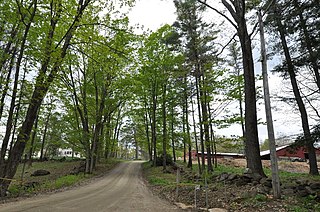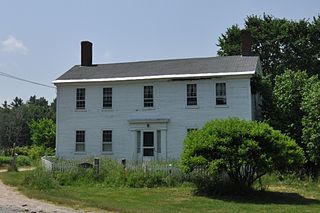
The William Cullen Bryant Homestead is the boyhood home and later summer residence of William Cullen Bryant (1794–1878), one of America's foremost poets and newspaper editors. The 155-acre (63 ha) estate is located at 205 Bryant Road in Cummington, Massachusetts, overlooks the Westfield River Valley amd is currently operated by the non-profit Trustees of Reservations. It is open to the public on weekends in summer and early fall for tours with an admission fee.

The Arnold Homestead is a historic homestead in the city of Huber Heights, a suburb of Dayton, Ohio, United States. Formed at the turn of the nineteenth century, it centers on an 1830s farmhouse that was built for an immigrant family from Virginia.

The Thorstein Veblen Farmstead is a National Historic Landmark near Nerstrand in rural Rice County, Minnesota, United States. The property is nationally significant as the childhood home of Thorstein B. Veblen (1857-1929), an economist, social scientist, and critic of American culture probably best known for The Theory of the Leisure Class, published in 1899.

The Reynolds Homestead, also known as Rock Spring Plantation, is a historic plantation on Homestead Lane in Critz, Virginia. First developed in 1814 by Abraham Reynolds, it was the primary home of R. J. Reynolds (1850-1918), founder of the R. J. Reynolds Tobacco Company, and the first major marketer of the cigarette. It was designated a National Historic Landmark in 1977. The homestead is currently an outreach facility of Virginia Tech, serving as a regional cultural center. The house is open for tours.

The William Whalley Homestead is an historic farmstead in Little Compton, Rhode Island. The main house is a 1-1/2 story wood frame structure, probably built sometime between 1815 and 1830. The property includes a barn and second outbuilding dating to the late 19th century, bounded by a low stone wall. The main house is a fairly typical Cape style house, five bays wide, with a central chimney. The property as a whole is a well-preserved example of a typical 19th-century farmstead in the area.

The Matthew Bowen Homestead, also once known as the Plaine Hill Farm, is a historic house at 94 Plaine Hill Road in Woodstock, Connecticut. It is now the Inn at Woodstock. Built in 1816, it is a prominent and well-preserved example of a Federal period farmstead, with a long history of association with the locally prominent Bowen family. The property was listed on the National Register of Historic Places in 1987.

The McClelland Homestead is a historic farm in western Lawrence County, Pennsylvania, United States. Located along McClelland Road northeast of Bessemer, the farm complex includes buildings constructed in the middle of the 19th century. It has been designated a historic site because of its well-preserved architecture.

The Goll Homestead is a historic farm complex in far western Fulton County, Ohio, United States. Located in German Township northwest of Archbold, the farm has been declared a historic site because of its role in the region's settlement.

The Bonde Farmhouse is a historic farmhouse located in Wheeling Township in Rice County, Minnesota, United States, approximately 1 mile (1.6 km) from Nerstrand. The private home was placed on the National Register of Historic Places (NRHP) on April 6, 1982. The farmhouse is significant both for its association with a prominent Norwegian immigrant family as well as its local limestone construction and outstanding integrity.

The Brattonsville Historic District is a historic district and unincorporated community in York County, South Carolina. It includes three homes built between 1776 and 1855 by the Brattons, a prominent family of York County. It was named to the National Register of Historic Places in 1971.

The Franklin Harris Farmstead is a historic farm complex located outside the village of Salem in Columbiana County, Ohio, United States. Once home to a prominent former soldier, the farmstead includes a high-style farmhouse from the 1890s, and it has been named a historic site.

The Brewster Homestead is a historic house at 306 Preston Road in Griswold, Connecticut. Built about 1740, it is one of the oldest surviving buildings in the town. The house was owned by six generations of the Brewster family, and originally was the centerpiece of a farmstead of 250 acres (100 ha). The house was listed on the National Register of Historic Places in 2000 by Ron and Kate Bauer.

William Scott Farmstead, also known as the Roberts House and Ennis Pond House, is a historic home located near Windsor, Isle of Wight County, Virginia. The house was built about 1775, and is a two-story, five bay, gable roofed brick dwelling. It has a rear frame addition dated to the mid- to late-19th century. The front facade features a pedimented one bay porch supported by Doric order columns. The interior retains much of its early Federal interior woodwork. Also on the property are the contributing servants' quarters, smokehouse, barn, and corn crib.

The John Adams Homestead/Wellscroft is a historic farmstead off West Sunset Hill Road in Harrisville, New Hampshire. The oldest portion of the farm's main house is a 1-1/2 story wood frame structure built in the 1770s. It is one of the least-altered examples of early Cape style architecture in Harrisville, lacking typical alterations such as the additions of dormers and changes to the window sizes, locations, and shapes. The farmstead, including outbuildings and an area of roughly 2 acres (0.81 ha) distinct from the larger farm property, was listed on the National Register of Historic Places.

The Plummer Homestead is a historic house museum at 1273 White Mountain Highway in Milton, New Hampshire. Built in the 1810s and repeatedly extended, it dates to the early settlement period of Milton, and is, along with the adjacent Plumer-Jones Farm, one of the oldest farm properties in the state. Both are now part of the New Hampshire Farm Museum. The house was listed on the National Register of Historic Places in 2002.
The John J. and Martha Sodergren Homestead is a historic late 19th-century farmstead in Maine State Route 161 in Stockholm, Maine. The central feature of the nearly 80-acre (32 ha) property is a modest house, built out of logs by Swedish immigrants. The property, one of the few remaining log structures built by Swedish immigrants in the state, was listed on the National Register of Historic Places in 2007

Amblers, also known as the Coke-Watts House, is a historic farmstead at 2205 Jamestown Road in James City County, Virginia, just north of the Jamestown peninsula. Its main house is a handsome 2-1/2 story brick structure, built in 1852 in the country style promoted by Andrew Jackson Downing, and expanded with a sympathetically styled Colonial Revival addition in the 1950s. The property includes two surviving 19th-century brick farm outbuildings, and landscaping from the 1950s that is also considered historically significant.
The Brady Hays Homestead was a historic farmstead in rural northern White County, Arkansas. The property included a house and barn built about 1885 by Brady Hays. The house was a double pen frame house of vernacular style, and the barn was a notably large two story transverse crib design, incorporating an older barn into its structure.

The Lowry W. and Hattie N. Goode First North Des Moines House, also known as the Allabach House, is a historic building located in Des Moines, Iowa, United States. The Late Victorian-style single-family dwelling is significant for its association with Lowry W. Goode. Goode was a prominent real estate developer in the Des Moines area in the 19th century. Built c. 1884 in what was the suburb of North Des Moines, this house is one of the last resources that calls attention to his work. The Goode's themselves built and occupied several houses in North Des Moines, and they lived here for about one year after it was built. They then used it as a rental property for a while until they sold it. The two-story brick structure features a main block with a rectangular plan, intersecting gables, a single-story bay window on the west elevation, a two-story extension on the south elevation, and a rear wing. The original porch has been removed. The house was individually listed on the National Register of Historic Places in 1998. It was included as a contributing property in the Polk County Homestead and Trust Company Addition Historic District in 2016.

The Chaffee-Hunter House is a historic building located in Des Moines, Iowa, United States. Built in 1886, the single family dwelling is named for its first two residents, Henry L. Chaffee and Edward H. Hunter who bought it from Chaffee in 1891. The house calls attention to Hunter who served as the local postmaster from 1894 to 1898. He conceived and implemented the idea of a streetcar-mounted collection box for the mail. It was later implemented in other cities in the country. The 2½-story frame Queen Anne structure features a gable-on-hip roof with intersecting gables, a brick foundation, wrap-around porch, and dormer windows. The house was individually listed on the National Register of Historic Places in 1998. It was included as a contributing property in the Polk County Homestead and Trust Company Addition Historic District in 2016.






















